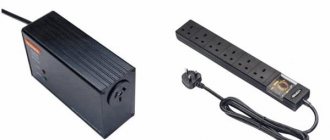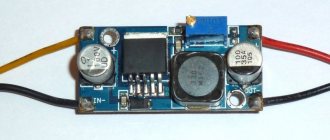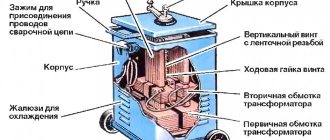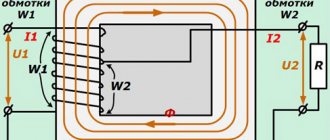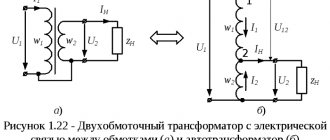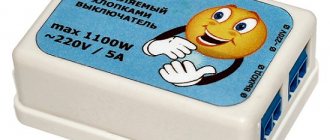Relay stabilizer circuit
How does a relay device work? When current enters this device, the first thing that occurs is its measurement. This is done by an electronic circuit. After this, a comparison is made between the level of the received current and the current level that should be at the output. At the end, the difference in volts is determined, which must either be added or subtracted.
Knowing this difference, the electronic device determines which relay should operate. Next, a specific relay is connected to the winding. As a result, the voltage reaches the required level.
Relay voltage stabilizer device
The heart of any relay stabilizer is an ordinary autotransformer; we have already written about it in some detail; by clicking on the link you can find out what it is and how it works.
Now it’s worth saying that the autotransformer has several taps - taps from the winding, each of which forms a secondary winding, with a different transformation ratio of the incoming voltage. In this way, the voltage can increase or decrease, and we will look at how this works below.
In addition to the automatic transformer, another important part of any relay stabilizer is the control board. It contains a number of components and solutions, in particular a voltmeter that measures the incoming voltage and control circuits that are responsible for switching the stabilizer modes.
Power relays directly switch the corresponding taps of the secondary winding of the autotransformer with the output contacts of the stabilizer.
A relay is a kind of circuit breaker; based on a signal, it mechanically closes or opens an electrical circuit. Depending on the model of the device, the number of such relays - stabilization stages, as well as their type, may vary.
In addition to the above, any electronic relay stabilizer also has fuses, indicators and other components on board, but we will not describe them; their type and quantity can vary greatly depending on the model of a particular device.
Now, to better understand how it works, let's look at its diagram.
Operating principle of a relay voltage stabilizer
First of all, the incoming voltage is measured in the stabilizer, then, depending on the results obtained, a signal is sent from the control board to open one or another relay, respectively, the electric current from one of the taps of the autotransformer, reduced or increased to the desired value, is supplied to the terminals of the stabilizer , to the consumer.
To fully understand the principle of operation of a relay stabilizer, you should definitely know about the operation of the autotransformer and its structure, if you have not yet read our article about it - now is the time to do so by following the link.
As an example of how a stabilizer works, let's assume that each tap of the autotransformer gives +/- 15 Volts of voltage change, it works as follows:
— If the voltage in the network is 220V , it is immediately transmitted to the consumer, the transformation ratio is 1. Accordingly, in the range from 205V to 235V (220V +/-15V), the voltage to the output of the stabilizer will be transmitted without changes.
— As soon as the incoming voltage drops to a value less than 205 Volts , the first secondary winding of the autotransformer is activated, with a transformation ratio of 1.075, thereby again producing 220 V (205 * 1.075) at the output. At this moment, the relay responsible for this tap of the autotransformer closes, releasing current to the output contacts of the stabilizer, and all others open.
Further, until the voltage drops another 15V i.e. up to 190V (205V-15V), this secondary winding will continue to operate with the same transformation ratio, thus, if the network voltage drops to 196V (switching limit to the next mode), the output is 211V (196 * 1.075).
— When the incoming voltage drops below 190V , the next relay is triggered, and the previous one opens, thereby turning on the next secondary winding of the automatic transformer, with a transformation ratio of 1.15 and the output voltage again becomes 220V (196 * 1.15) and so on, every 15V the winding switches to, say, 145V - after which the stabilizer goes into protection.
- If, on the contrary, the voltage in the network increases above 235V , using the appropriate relay, the step-down secondary winding is activated, with a transformation ratio of 0.94, and again the voltage in the network is equalized to the required 220V (235 * 0.94).
I think that now the principle of operation of a relay stabilizer is clear to you, now let’s look at what strengths and weaknesses a stabilizer of this type has, and in what areas it is best used.
Internal structure
Why can inverter stabilizers achieve such efficiency and proudly bear the title of leader among all types of stabilizers? This is achieved thanks to a different operating principle and, of course, a different structure (it is shown in Fig. 1).
A classic inverter stabilizer consists of: - input filters (IF); — rectifier and power factor corrector (KKM-V); — capacitors (VIP) — DC-AC voltage converter (DCV); — microcontroller (MK).
Rice. 1. Inverter stabilizer circuit.
It is worth noting that the rectifier and DC-DC converter are inverters, which are built on the basis of IGBT transistors, that is, based on insulated gate bipolar transistors, and MOSFET, that is, on a metal-oxide semiconductor.
These transistors can switch very high currents and experience very little energy loss during operation.
Advantages
Low cost
It is precisely because of their low price, relative to other types of stabilizers, that relay models are so popular. At the same time, in other respects, they completely cover the needs of the modern consumer in most cases.
Quite fast stabilization speed, on average 5-30 ms
Relay stabilizers react to changes in incoming voltage at high speed, and allow you to protect your electrical equipment even during sudden drops or surges
Simplicity and maintainability
Possessing a simple, understandable architecture, relay stabilizers do not have a mass of complex components that could fail. There are not many possible problems and all of them have been studied and described, are easily diagnosed and can be corrected at home, even if you have only superficial knowledge and skills in electrical repair.
Flaws
When switching frequently, power relays fail
One of the most significant disadvantages of relay stabilizers, in my opinion, is the possibility of failure of power relays if mode switching occurs quite often and intensively. Contacts oxidize over time or can burn at high currents, which greatly reduces the service life of the relay.
Clicking when switching relays
Another feature that can become a serious drawback if the relay stabilizer is installed somewhere near you is the sound of the relay switching, which clicks quite loudly.
Relatively high stabilization error, on average about 5-8%
Depending on the number of taps from the autotransformer - secondary windings and, accordingly, the number of relays in the circuit, the relay stabilizer has a degree of stabilization error, on average 5-8%, and this is quite a lot. As you can see from the calculations presented above, the stages at which stabilization occurs are within 15 Volts, which is equal to 6.8% of 220V; particularly sensitive electrical appliances can react to such indicators.
If you require normalization with greater accuracy, be sure to consider electromechanical voltage stabilizers.
Short-term interruption of current supply at the moment of relay switching
When switching a relay, during a change of modes, for a very short time, the current supply is interrupted when the contacts of one relay are already broken, and the second is just closing. In this case, a surge or voltage surge often occurs. This can have a negative effect on particularly sensitive electronic components and can also be reflected, for example, in a short-term change in the brightness of the lamps.
Power drop at low voltage
Relay stabilizers produce the full power declared by the manufacturer only in a fairly narrow range of incoming voltages, often only up to 190 Volts, then the performance rapidly drops and at some point reaches only 40-50% of the nominal.
Top 5 most popular
| Model | Parameters / Power | Information |
| Resanta ASN |
Power: | Catalog Review |
| IEK Home |
Power: | Catalog Review |
| Era of SNPT |
Power: | Catalog Review |
| Voltron Energy |
Power: | Catalog Review |
| Rucelf SRWII |
Power: | Catalog |
Where are relay stabilizers used?
If we analyze all the pros and cons of a relay stabilizer, we can conclude that it can cope with most household tasks. Almost everywhere where precision stabilization is not required, but high speed is required, a relay stabilizer is simply irreplaceable.
In particular, relay stabilizers are actively purchased to equalize voltage in an apartment or country house, as well as in a garage. In addition, almost any household appliance that has a motor or heating element, for example, a refrigerator, washing machine, dishwasher, or power tool, works great with inexpensive and fast relay stabilizers.
When voltage drops or, conversely, power surges do not occur very often, but still happen during the day, for example, in a gardening community, where the voltage in the network often strongly depends on what your neighbors are doing at the moment, depending on this it can change rapidly, a relay stabilizer is the optimal solution.
If you have some kind of equipment that is sensitive to even the slightest voltage surges or electric current parameters, as well as to the accuracy of stabilization, for example, a high-quality audio amplifier, you should choose a different type of normalizer.
Installation method
Stabilizers are installed on the wall or floor. Here it’s more convenient for anyone. It is important that the room is dry, free of dust and critically low or high temperatures. There must be space around the appliance to ensure effective cooling. If we are talking about a private house, then it is optimal to install the stabilizer near the distribution panel, but basements or attics are definitely not suitable.
The best relay voltage stabilizers
Currently, there are quite a lot of players in the stabilizer market, large and small manufacturers, each with several lines of models, with different output power and functions, so it is not easy to name any specific successful products.
But of course, by studying the experience and reviews of our colleagues, suppliers and clients, we can identify several of the most optimal manufacturers in various categories of consumer properties, using the example of 5 kW - kVA models in particular:
ENTRY LEVEL
Of the most affordable, inexpensive , but at the same time quite high-quality relay voltage stabilizers, I advise you to take a closer look at the models of the following manufacturers: Resanta Quattro Elementi. These stabilizers are used especially successfully in the country house, garden plot or garage, as well as when powering household appliances or power tools.
Stabilizers from these manufacturers are often installed in apartments and cottages, boiler rooms and other places where reliability is important, both in stabilizing and protecting electrical appliances from the negative effects of poor-quality electrical current parameters.
Inexpensive and high-quality relay stabilizer RESANTA ACH-5000/1-C (~ 5400 rubles)
Quattro elementi stabilia 5000 - Another affordable relay stabilizer with good reviews (~6000 rubles)
MORE..
PRICE QUALITY
In terms of price/quality ratio , with an emphasis on reliability, quality and functions, such as a wider range of stabilization, additional protection and filters, the most interesting manufacturers of relay stabilizers, according to a large number of consumers, are: Energy and Rucelf of the following models:
One of the most successful models of relay stabilizers, combines affordable cost and high reliability RUCELF StAR-5000 (6500 rubles)
Energy ACH 5000 is a Russian-made relay stabilizer, in a compact, portable design, 7 stages of stabilization. (~7000 rubles)
ADVANCED MODELS
The most expensive and advanced relay stabilizers, with the maximum number of options, a high degree of stabilization and other high-level characteristics, which are designed for installation in more critical places that are demanding in terms of quality, reliability and accuracy of voltage parameters, for example, in production, in cafes, shops and etc. produced by manufacturers: Lider, Energy, Uniel
Energy Voltron 5000 is a professional high-quality relay voltage stabilizer, with very good characteristics and additional functions. (~9000 rubles)
Uniel-rs-1-5000ls - relay stabilizer with the widest stabilization range, high response speed, its characteristics are compared with ... (~ 12,000 rubles)
If you know other worthy manufacturers or successful models of relay stabilizers, be sure to write in the comments to the article. In addition, ask questions, and if you have comments or criticism, express them.
If you think that a relay device is not what you are looking for, be sure to study the features of stabilizers of other types and read reviews of models for different typical cases, all this and much more awaits you in upcoming articles, follow the release of new materials, subscribe to our VKontakte group.
Model overview
The easiest way to review modern stabilizers for the home is to focus on the advantages and disadvantages of several branded samples. For this purpose, models were selected representing such competing ones as “Energy”, the domestic development “Shtil”, as well as a brand called Sven.
The rating of stabilizers for the home is headed by a model from, which produces products with an excellent price-quality ratio. The devices of this company are capable of operating with loads of various sizes (power from tens to hundreds of watts). The Resanta assortment includes many single-phase relay-type models, but samples with double voltage conversion (inverters) are also often found. This brand has practically no disadvantages (except for the price).
The second position in the ranking is occupied by Energia, a diversified company that has only recently mastered the production of high-quality stabilizers. All models of this manufacturer are distinguished by a proven quality-price ratio and are in constant demand among Russian consumers. Their advantages also include a wide selection of different designs.
Next comes , which produces budget products and mid-price models, as well as premium samples. Especially popular are electronic inverters, which are not inferior in their capabilities to modern uninterruptible power supplies.
The last on this list is the Finnish company Sven, whose products are suitable for both home and office use. Prices for products from Finland are quite affordable for the average user with consistently high quality. According to the manufacturer, the service life of all manufactured models is on average at least 10 years.
